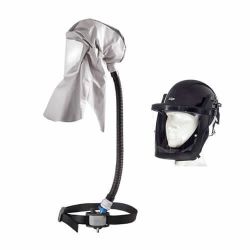Supplied air respirators
Supplied air respirators - also known as SARs or airline respirator - are respiratory protective equipment that provide the highest protection level. Well-suited for many industrial applications, supplied air respirators are ideal in hostile, poorly oxygenated environments as well as areas with extreme concentrations of a pollutant (paint booths or asbestos removal sites).
There are 2 categories of supplied air respirators: the constant-flow SAR, that can use a wide range of face pieces (hoods, protective screens, visors with helmet, etc.) and the supplied air respirator mask with on-demand valve and full mask, mainly intended for confined spaces (standard EN14593-1).
-
-
-
-
Fresh air supply system DUCT A ECO, Supplied air respirator (tank cleaning)
Starting at $1,676.48Quickview -
-
-
The supplied air respirator
Before choosing a supplied air respirator equipment, it is essential to deeply evaluate risks on the concerned site and to implement the proper equipment to fulfill the required task. Thus it is necessary to ask the right questions:
Primary air supply
It can either be the plant or laboratory’s air supply system, a supplied air compressor or even compressed air cylinders (usually on a breathing air cart). If using the plant compressed air network, it would be necessary to check if this breathable air network is equipped with a monitoring system to be sure that air has been purified from water, oil and gases (carbon oxides and volatile organic compounds).
Low pressure alarm
There are two different ways for a user to be alerted in case of pressure reduction on the supplied air respirator system. Either through a line whistle (whistling below a certain air pressure level), or through a DS4 (automatic distress signal) that emits an audiovisual warning.
Last resort air reserve
Is it required to have a last resort air reserve in case of accidental interruption of the breathable air supply? If yes, it would be necessary to wear a last resort compressed air cylinder at the belt and along the leg to safely evacuate the hazardous area.
Supplied air respirator system composition
A supplied air respirator system is composed by three elements. A breathable air supply using either a breathing air cart or an existing breathable air network equipped with an air purifying unit. The second component is a harness the user wears which gathers every connections and lastly a respiratory mask – same as those used with self-contained breathing apparatus (quarter turn connection).
Breathing air cart
Designed to carry up to four compressed air cylinders, an SAR breathing air cart incorporates all respiratory protection equipment such as a pressure relief valve and a pressure regulator. It is designed with advanced materials, its steel frame is treated with an anti-corrosion epoxy coating, ideal for use in severe conditions.
Air purifying unit for supplied air respirator system
This is a two stage purifying system that eliminates particles, water and oil droplets and smell from the plant breathable air network. The air quantity is thus theoretically unlimited. This way, supplied air respirators are ideal for long term works – contrary to an SCBA. The purifying unit remains necessary in order to ensure the purity of air being injected into the facepiece.
Facepiece selection
All of our airline respirator range is fully compatible with a large range of face pieces (half mask, full face mask, supplied air respirator hood…) in order to meet the most specific requirements. A supplied air respirator system is the supplied air system combined to a full mask with an on-demand valve!
Supplied air respirator for asbestos removal: The RAS Asbestos
The RAS Asbestos is a specific device especially designed for asbestos removal applications, from the classic supplied air system (standard RAS). The RAS Asbestos operates the same way than classic airline respirators and features an additional filter located in the medium pressure supply hose.
This P3 category filter eliminates particles from 0.01 micrometers, protecting its user against asbestos particles that penetrate the "Pigtail" connector when connecting to the supplied air system.
Its harness is also made of a slicker material in order to facilitate the decontamination after use and the device servicing.



